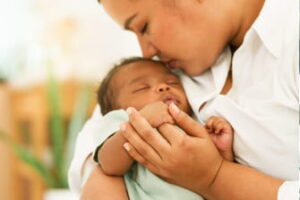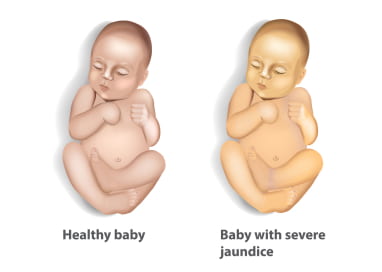What Are Common Kernicterus Causes?
 Kernicterus occurs when bilirubin builds to extremely high levels and spreads into the brain tissue and central nervous system. Bilirubin is a chemical made by the body when old red blood cells are broken down.
Kernicterus occurs when bilirubin builds to extremely high levels and spreads into the brain tissue and central nervous system. Bilirubin is a chemical made by the body when old red blood cells are broken down.
Newborn jaundice is usually what causes kernicterus. Babies with jaundice have yellowish-looking skin, whites of the eyes, and mucus membranes. The yellow coloring comes from the bilirubin.
Jaundice is a common and treatable condition. However, if left untreated, it can become so severe that it leads to kernicterus, which can cause permanent brain damage.
“No baby should develop brain damage from untreated jaundice.”
Is Jaundice the Only Cause of Kernicterus?
No. Although jaundice is one of the leading kernicterus causes, other conditions can trigger the condition.
- Biliary system problems: These can affect the ducts and organs that make and store bile, including outside and inside of the liver and gallbladder.
- Breastfeeding jaundice: Also called suboptimal intake jaundice, this can occur when enzymes in breast milk disrupt bilirubin production, increasing the levels in the baby’s blood.
- Crigler-Najjar syndrome: This is one of the top causes of newborn jaundice. It is a rare and severe disorder that creates toxic bilirubin levels in the blood.
- Gilbert syndrome: This is a common condition in which the liver doesn’t process bilirubin properly.
- Hypoalbuminemia: Occurs when the body does not produce enough albumin (a protein in blood plasma made by the liver.)
- Medical negligence: Undiagnosed or untreated jaundice in newborns resulting from a medical error is sadly one of the kernicterus causes.
Risk Factors for Kernicterus
The leading kernicterus cause is known to be high levels of bilirubin. Additionally, certain risk factors are linked with kernicterus but do not necessarily cause it.
Here are some of the main risk factors for kernicterus.
Bruising During Birth
Newborn infants with bruises at birth are more likely to develop jaundice and kernicterus. Bruises can be a result of birth trauma, which occurs when organs or tissues are damaged during the birthing process. When large bruises heal, the body may release high bilirubin levels, leading to jaundice.
Dark Skin Coloring
Doctors may miss jaundice in babies with darker skin colors. They can check the inner lips and gums to check for jaundice. If doctors have any doubts, they should perform bilirubin tests.
Different Blood Types Between Mother & Newborn
Mothers with an O blood type or Rh-negative factors may have babies with higher bilirubin levels. Doctors should give a medication called RhoGAM® to mothers with Rh factors to prevent Rh incompatibility from developing during pregnancy.
East Asian Ethnicity
Babies born to families of East Asian descent are more likely to develop jaundice, one of the main kernicterus causes.
Failure to Diagnose or Treat Jaundice
Babies are more likely to develop kernicterus if doctors fail to diagnose or treat jaundice promptly. In this situation, birth injury medical negligence could be at play.

Jaundice Family History
Babies with siblings who had jaundice are more likely to develop jaundice and kernicterus. This is because some families inherit jaundice-causing conditions, such as low levels of G6PD. This enzyme helps prevent cellular damage.
Premature Births
Preterm babies born before 8.5 months or 37 weeks are more likely to have jaundice and kernicterus because their livers are not fully developed. Less developed livers may not be able to regulate high levels of bilirubin.
Trouble Feeding After Birth
Newborn babies with feeding problems may not be able to effectively remove waste from their bodies. This, in turn, can lead to a buildup of bilirubin in the blood, leading to jaundice and, eventually, kernicterus.
If you have questions about kernicterus causes, connect with one of our labor and delivery registered nurses.
Newborn Kernicterus Treatment
If you believe your newborn has kernicterus, get medical help right away. Kernicterus is a serious condition and should be treated without delay.
If the condition is suspected, the medical team will observe your infant for kernicterus symptoms.
- Arched body like a bow (the body is bent forward, and the head or heels or neck are bent backward)
- Extreme sluggishness and sleepiness
- Fever that occurs with other symptoms
- High-pitched cry that does not sound normal
- Poor muscle tone or hypotonia (an overly floppy body)
- Seizures and muscle spasms
- Unusual eye movements
Next, the care team will perform a jaundice bilirubin test by placing a light meter on the baby’s head. If the bilirubin level is high, the team will order a blood test.
If the blood test bilirubin level is high, the team will treat your baby by putting them under special lights. This type of light therapy is called phototherapy and will not hurt your baby. The team will also increase the baby’s milk intake.
Doctors will perform a blood exchange transfusion if the baby has very high bilirubin levels.
Can Kernicterus Cause Brain Damage?
Yes. Kernicterus can cause long-term brain damage. Fortunately, doctors almost always diagnose kernicterus before bilirubin levels become high enough to cause serious brain injury.
- Deafness or hearing loss
- Developmental disabilities and learning problems
- Movement disorders, such as cerebral palsy
- Problems moving the eyes, especially looking up
In some cases, brain damage caused by kernicterus can tragically result in death.
Legal Options for Newborn Kernicterus Caused by Medical Negligence
If your baby developed kernicterus due to the medical team’s failure to diagnose or treat jaundice, you might have legal options. Depending on the details of your case, you may be eligible to file a birth injury lawsuit against your baby’s health care team.
If you win, you may receive financial compensation for your baby’s treatment, medical expenses, medications, pain and suffering, and more.
You may also be able to receive compensation for lifelong disabilities and medical necessities if your child developed cerebral palsy, deafness, hearing loss, movement problems, or developmental disabilities due to medical negligence.
Seek Help With a Newborn Kernicterus Medical Negligence Claim
Discovering that your newborn has kernicterus can be traumatic, especially if they experience potentially life-threatening or severe complications.
Connect with us today to learn how we may be able to help. We can answer your questions about kernicterus causes and connect you with a top birth injury lawyer if you are eligible.
Get started with a free case review today.
Kernicterus Causes FAQs
What is kernicterus caused by?
Kernicterus is caused by a buildup of bilirubin, a chemical created by the body when old red blood cells break down. One of the main symptoms of bilirubin buildup is jaundice, or the yellowing of the skin, whites of the eyes, and mucus membranes. Other causes of kernicterus include Crigler-Najjar syndrome, Gilbert syndrome, and biliary system problems.
How common is kernicterus in newborn children?
According to the Centers for Disease Control and Prevention (CDC), about 60% of all babies develop jaundice. However, it is rare for jaundice to turn into kernicterus. The dangerous kernicterus bilirubin level is almost always avoidable because jaundice is usually treated before it becomes a problem.
How do I know if my baby has kernicterus?
Babies with kernicterus have orange or yellowish skin, extreme fatigue, and high-pitched cries. They may also be floppy and have difficulties feeding.
If you suspect your baby has kernicterus, seek emergency medical help right away. A medical team will be able to determine what is causing your baby’s symptoms.
Can a baby recover from kernicterus?
Yes, babies can recover from kernicterus if they receive treatment on time. However, if they don’t receive treatment on time, they may develop permanent brain damage, which can cause deafness or cerebral palsy.
What are the signs of kernicterus?
Babies with kernicterus are likely to have orangish or yellowish skin, extreme fatigue, fussiness, and lower-than-average diaper changes. They may also have poor muscle tone and unusual eye movements. Fever is likely to occur with any of these symptoms.
How common is kernicterus in newborns?
Kernicterus is considered extremely rare. According to a 2019 Swedish study, only 1.3 out of 100,000 infants develop kernicterus.
Can a doctor’s error cause kernicterus?
Yes, if a doctor fails to diagnose and treat neonatal jaundice in time, your baby may develop kernicterus.




